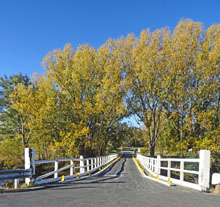
Old Towong Bridge |
Joining the throng walking from the top of Crackenback Chairlift at Thredbo is akin to becoming a part of a pilgrimage. On each occasion we return the walk offers something different. Journeys to Kosciuszko’s summit can begin at all points of the compass. For me the journey begins on Towong Hill Road, close to Sir Paul Edmund Strzelecki’s route along the Murray Valley between Towong and Bringenbrong in 1840. Across the border on the NSW side of the Murray River, some claim that Strzelecki walked up stream on their side of the River, but I believe that he chose the Victorian side, as it was less swampy!
Aborigines used these routes on their way to find Bogong moths; early settlers followed in their wake. Strzelecki was the first explorer to leave a scientific record of his achievement in climbing and measuring the height of Mt Kosciuszko.
Strzelecki is an untold hero of the Upper Murray and particularly of Towong. Most people know that he gave the name to our High Country’s highest mountain Kosciuszko, naming it after the American Revolutionary War hero Tadeusz Kosciuszko. None of us know how many scientists, latter day explorers, writers and artists Strzelecki inspired. Only half a century after first white settlement, Strzelecki was a catalyst for the age of enlightenment in Australia where people were beginning to push the frontiers beyond the known world of the nineteen counties around Sydney. The search for gold, the need for new pastures and scientific knowledge were compelling incentives for early exploration. Due to the scientific orientation of Strzelecki’s writings, it is an era that historically poses more questions than it answers.
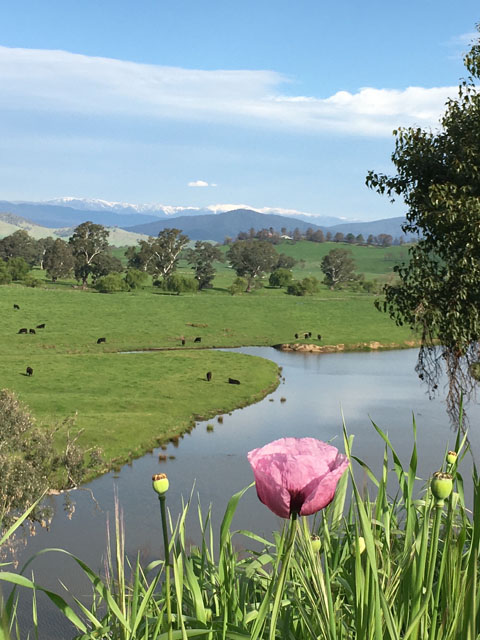
Mermaid Lagoon |
The scientist George von Neumayer may well have been inspired by Strzelecki’s March 1840 expedition. He carried out magnetic surveys of Victoria between 1858 and 1864, while his accompanying artist Eugene von Guérard painted Mount Kosciuszko from many different angles. In his painting Mount Kosciusko from the Victorian Border Ranges (Mount Hope Ranges) von Guérard depicts the figure of von Neumayer on horseback as being belittled by the enormity of the landscape, suggesting treasures yet to be discovered.
Locally in the Upper Murray Strzelecki may have also inspired Emma Isobel Mitchell, Messrs James and B. Findlay, P. Mitchell and W. Stuckey to climb Kosciusko where they painted their names on a metal lid and left it on the summit in the summer of 1884. I wonder if Strzelecki’s name was part of a conversation that brought poet Banjo Paterson into the High Country and the Upper Murray?
Strzelecki’s legacy has continued to inspire tourists for over 182 years.
Knowing that Strzelecki and his party passed along the Murray Valley on the Victorian side of the Murray River between Tintaldra and Bringenbrong, nationally and internationally acclaimed author, skiing champion and mountain woman Elyne Mitchell spent a lifetime researching the mystery of whether it was Mt Kosciuszko or Mt Townsend that Strzelecki had climbed. Together with her husband Tom, Elyne had climbed both mountains and scaled many of the neighbouring peaks. Many Upper Murray stockmen referred to the High Country as ‘Kosciusko’ which had already sown seeds of confusion as to which peak was the highest.
In the late 19th or early 20th century Arnold Playle took a photograph depicting the Murray Valley from Towong with the snow-covered High Country in the distance. Perhaps unintentionally confirming the name, he created a postcard from the photograph and captioned the scene ‘Mt Kosciusko’ as if the name applied to the whole Main Range.
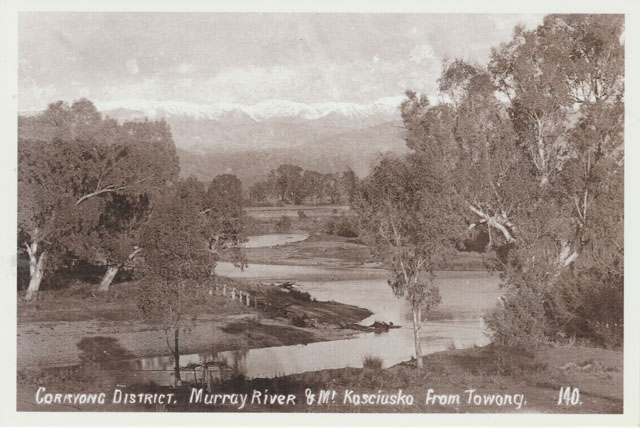
Arnold Playle, Murray River with a view of Kosciuszko Masiff. Printed with John Whitehead's permission |
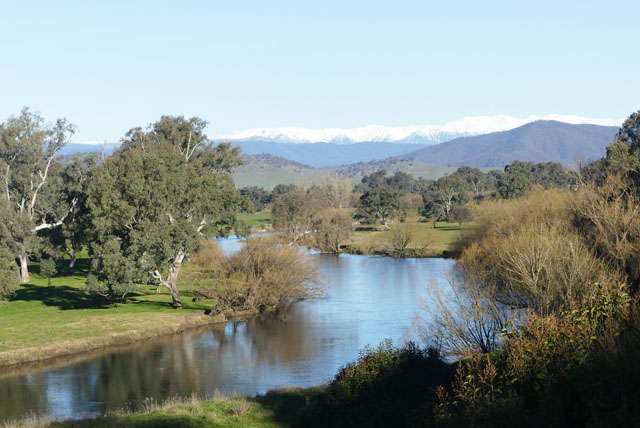
Contemporary view on the Murray River with Snowy Mountains on the horizon. From Towong one can see Mt Townsend,yes, but Mt Kosciuszko cannot be seen from here |
Having broken out only five months before the centenary of Strzelecki’s ascent of Mt Kosciuszko, World War Two overshadowed commemorations on 15 February 1940. Nonetheless groups from both sides of the Great Dividing Range gathered on Kosciuszko’s summit to commemorate the event. Among the visitors was a large group of horsemen who had ridden from Corryong and District in Victoria, arriving at the Summit after some 70 miles journeying from the head waters of the Murray River.
The reality was a little more complicated. On Thursday 29 February, in the Corryong Courier a front page article From Corryong to Kosciusko: Local Party makes the trip the writer mentions Councillors ‘H. Nankervis, H. Harris, D. Braniff and Messrs. W. H. Kaighin, G. Nankervis, L. Masters, J. Cox, and [one other]*, the occasion being the unveiling of a tablet in commemoration of the centenary of the founding of Mt Kosciusko by Count Strzelecki’ on 17 February. Part of the reason for the expedition was to look at the viability of a road from Khancoban via Geehi.
Bearing witness to the ongoing debate about which mountain Strzelecki climbed, Elyne quoted the renowned Jindabyne stockman as commenting that although he had subscribed £10 for the monument to Strzelecki, ‘he would have given twice as much if they had put it on the right mountain.’
Elyne was a great admirer of poet David Campbell who found inspiration for his poem Strzelecki for Manning Clark in Strzelecki’s unrequited love for Adyna Turno back in his homeland of Poland. Of Strzelecki David Campbell wrote:
The party climbed Mt Townsend through a whole
Avalanche of wild flowers only to find
The south peak topped it – much like one in Poland
Called Kosciusko, Strzelecki claimed. The Pole
Scaled it alone, and when a cloud came down
Shutting the alpine vastness in a room
With his brief triumph, Strzelecki picked the bloom
Of one of those rare snowflowers sprung from stone
Remembering Adyna Turno and her love,
And joined the others happily enough.
Strzelecki’s story is just one facet of Towong’s unsung heritage story which begins at the Towong Turf Club and continues along Towong Hill Road. The racecourse and the grandstand are among the most picturesque racecourses and grandstands in regional Victoria; no wonder it is often called the Flemington of the Bush. In the walkway beneath the steps leading to the grandstand there are the Turf Club’s 150th anniversary history display boards. Here you will find Upper Murray hidden gems with many stories of colourful characters and events.
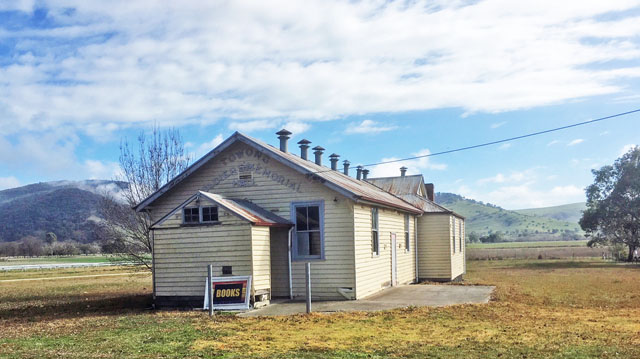
Towong Soldiers Memorial Hall |
Beside the road to the Turf Club is the Towong Soldiers’ Memorial Hall listing those members of the Towong community who served in both World Wars. Descendants of those brave servicemen’s families still live in Towong, Corryong and in the neighbouring districts. Towong Hall is a gathering place for community meetings, social gatherings and in emergencies such as the Black Summer 2020 fires. After the fires the Hall was used as a distribution point for the many generous donations sent to help our community and it is where a local child pinned his or her note thanking ‘The Fireys’.
A house now stands on the site of the old Towong Pub just before the Upper Murray Highway turns left towards Tintaldra. There have been two pubs on the site and like many other contemporary country pubs certainly one of them suffered the ravages of fire. The exact date the last drink was served there seems to have been lost in time. The pub used to provided stabling and fodder for drovers travelling with stock grazing the long paddock and also for racehorses and their owners. Today’s owner of the house standing on the site of the former pub told me about the artefacts he has found – bridle bits, stirrups, horseshoes and girth buckles not to mention much broken glass.
Towong’s story goes back beyond early settlement with maps showing streets that were never made. Because Towong was swampy and Sydney Grandison Watson had given a block of land near the school to Corryong, the latter was developed as the local town. The proximity of Mt Elliot’s gold mines brought attention to the nearby largely canvas village and also to Corryong. Rumours grew that Corryong’s streets were paved with gold! Nonetheless Towong village never died – it was hiding its light while it waited for life to return. In recent years newcomers have seen its potential and vibrant young people have moved to the area to build their homes and raise their children.
The Murray River is Towong’s and the Upper Murray’s greatest asset and many stories have been told about the old wooden truss bridge. One winter a ute skidded on the bridge and broke the railings which then miraculously saved both driver and vehicle from plunging down into the icy river. Local identity and former President of The Man from Snowy River Museum John Whitehead who grew up in New South Wales, tells stories of riding his horse and fording the river further downstream at the Light House crossing, and then once Towong bridge was almost finished, riding over the bridge before all the floorboards were secured. If his mother had known she would have had a heart attack!
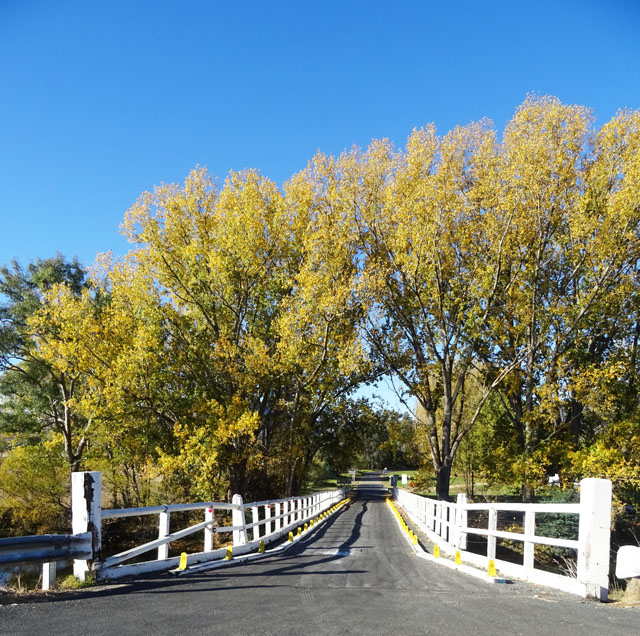
Old Towong Bridge |
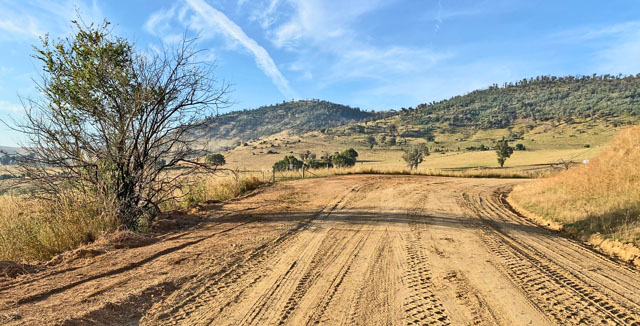
Not far away from the bridge, on a nicely landscaped Towong Hill Rd a Strzelecki Memorial Plaque will be unveiled in November 2023 |
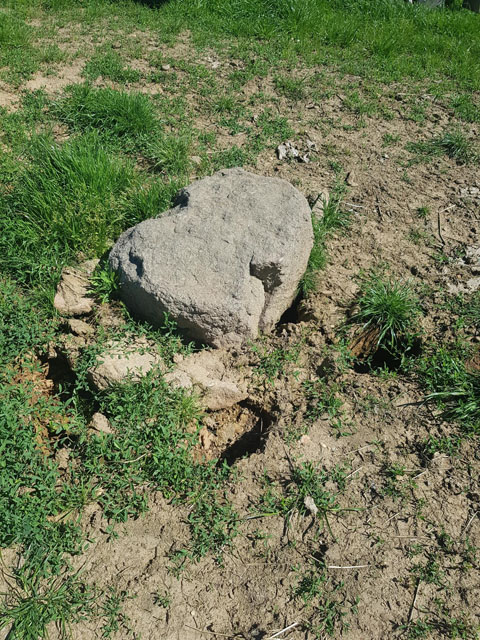
Guise's Well. Strzelecki travelled this way |
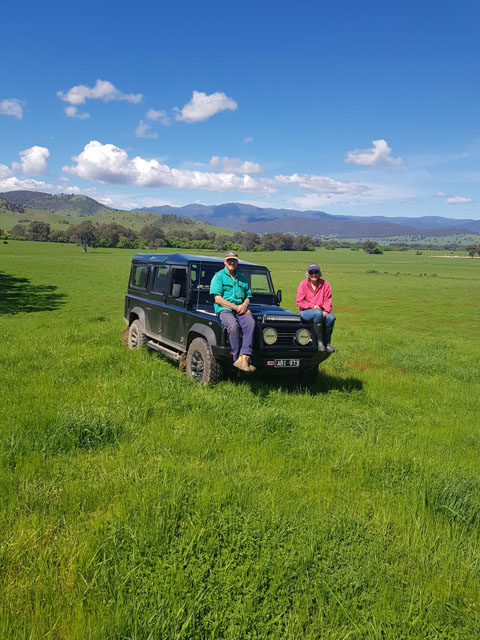
Honor and Mark Auchinleck on their property, formerly Guise Station.Photo John Murphy |
Until the new bridge gets completed sometime in 2023, the Murray River cannot be crossed at Towong, but there is pedestrian and bicycle access behind the bridge worksite to Towong Hill Road. In good weather walkers and cyclists can enjoy one of the finest views of the High Country lying ahead. If time allows, walkers and cyclists can continue along Towong Hill Road and Strzelecki’s approximate route towards the High Country. The road runs above a billabong or oxbow lake called the Mermaid Lagoon, possibly named for its one time mermaid shape. Some say that there were those who spent a bit long propping up the bar and then were lured by the siren call of the mermaid!
About 2.3km from Towong Bridge, on a fence line between two paddocks are the foundations of William Guise’s homestead, the first house on the property that later became known as Towong Hill. On the floodplain below the foundations is the well from which the Guises drew their water.
Further on, some 3.3km from the Bridge, and on the left side is the Cathedral – a natural deep erosion gully in which the sides have been sculptured by the weather into all kinds of magical shapes. The erosion has been formed by springs that seep down, gradually forming over many years from what would have once been a gully into the mini canyon we see today. In wet seasons a stream flows through to feed swampy ground and a dam in the paddock below its mouth. In drier weather water seeps through beneath the surface soil.
The Cathedral created such interest that Walkabout Geographic Magazine: Australia and the South Seas published a black and white photograph on the front cover of its November 1936 edition. For many years similar photographs were displayed in the railway carriages on the Spirit of Progress, the Melbourne to Sydney train. Elyne Mitchell was so concerned about the erosion in the gully that in 1945 she planted a forest of poplars to hold the soil. In this way the Cathedral played its part in inspiring the articles she wrote for the wartime Sydney Morning Herald. These articles became the foundations of two of the chapters of Elyne’s Soil and Civilization published in 1946.
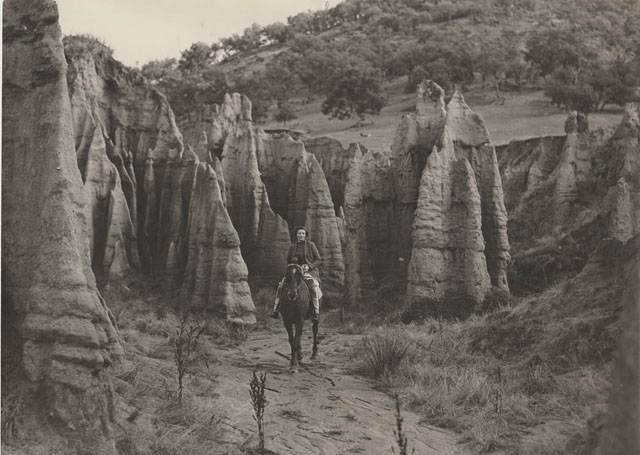
Legendary Elyne Mitchell, Honor's mother, riding a horse in the Cathedral |
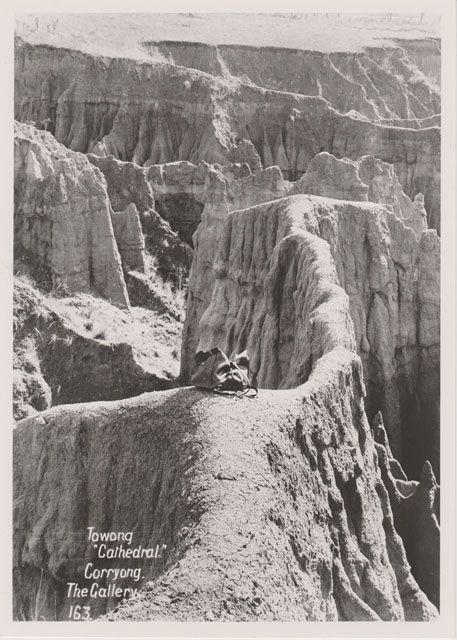
Arnold Playle's photo published with John Whitehead's permission. For your curiosity: Mr Playle was John's grandfather. |
A few hundred meters on you pass the turning into the drive to Towong Hill, the home to which Elyne Mitchell returned with her notebooks filled with notes to write the books that made her career. The ruins of the mansion stand as a memorial to a fine children’s writer, conservationist, historian, keen skier and bushwalker. Having been fortunate enough to grow up in the homestead, I prefer to remember it how it was. Rather like The Sleeping Beauty, the homestead’s charred shell is waiting for the future to breathe life back into it.
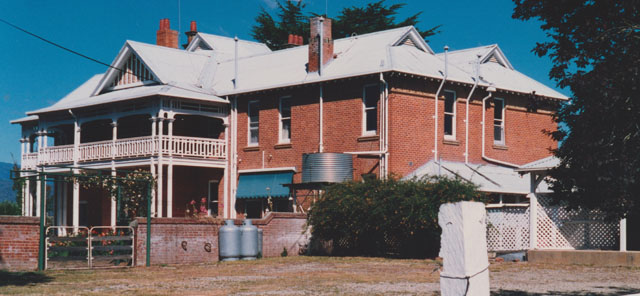
Honor's family home - The Towong Hill Station |
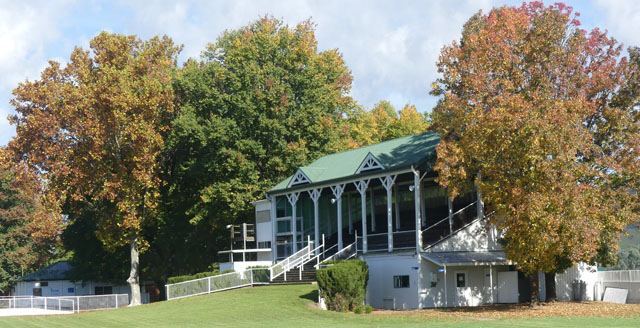
The Grandstand |
Venture some 400m further and the Towong Hill stud stables come into view at the bottom of the hill on the left. This was home to the well-known stallion and foul play was widely believed to have been the cause of Melbourne Cup favourite Trafalgar’s loss to Comedy King in 1910.
Continue uphill to the junction with the B400 running from Corryong to Khancoban. Directly opposite are the lower slopes of Mt Elliot where before the turn of the last century gold mining began, bringing people and money and ushering a new era into the Upper Murray.
For those wishing to continue following Strzelecki’s footsteps, continue on down to Bringenbrong Bridge. The original ford was located 200 – 300m downstream from the bridge and marked with a cream can lid nailed to a post. Over the years the river’s character has changed and the lid has long since disappeared so it is impossible to identify the ford’s precise location.
But Strzelecki’s trail doesn’t finish there and it isn’t necessary to venture as far as the top of the Crackenback Chairlift at Thredbo! Fit and experienced bushwalkers and skiers could do as Tom and Elyne Mitchell did during the winter of 1936 and climb the Hannel Spur. High Country visitors might also choose to follow in the trail of the Silver Brumby, taking the Alpine Way to Dead Horse Gap and either walking out to the Cascades or up onto the Ramshead range.
Honor Auchinleck
Footnotes. W. L. Havard, Sir Paul Edmund Strzelecki, Royal Historical Society, Vol xxvi, Part 1, 1941
Elyne Mitchell, Discoverers of the Snowy Mountains, The Macmillan Company of Australia Pty Ltd, Melbourne 1985 Dr Honor Auchinleck is a daughter of the renowned writer, author of Silver Brumby series Elyne Mitchell, and of the famous politician, Tom Mitchell, MP
| 

